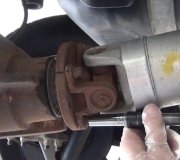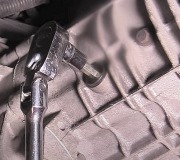You have the wrong transmission fluid. My 1994 Grand Voyager does this too.
All of the great clues and observations you listed are the same as for my van. Chrysler, which is famous for developing innovations since the 1950's that benefit their customers, as opposed to GM's innovations that benefit GM at the expense to their customers, invented the lock-up clutch for the torque converter starting with some 1976 models. That is designed to eliminate the slippage that allows the engine to remain running when the transmission is in gear and the car is stopped. That clutch is just there to improve fuel mileage.
All torque converter clutches engage between roughly thirty five to forty five mph, only in the higher gears, only once the engine is warmed up, and only when you are not at wide-open-throttle or applying the brakes. It is springtime, so you have to drive a shorter distance before the engine reaches the temperature at which the clutch will engage.
To prevent an uncomfortable clunk when the torque converter locks up, it engages gradually. It is supposed to slip a little around thirty five mph and it will be fully-engaged by around forty five mph. The shudder you feel is from the clutch grabbing too hard, engine torque breaks it free, then it tries to lock up again, in rapid succession. The way to prove this to yourself is when the shudder occurs, hold the accelerator pedal and road speed perfectly steady, then lightly tap the brake pedal. The computer sees the brake pedal as you're planning on coming to a stop, and in preparation for that, it unlocks the clutch so the engine does not get snubbed off. The shudder will stop occurring, then start again two or three seconds after you release the brake pedal.
Do not waste your money on additives in a can. If it was that simple, we would all be doing that. You need to have a standard, simple transmission drain and fill with a filter change. That will replace about half of the fluid which is enough to replenish the required additives. If you have this done by a Chrysler dealership, they will know the correct fluid to use. If you have this done at an independent shop, be sure to tell them it is the shudder that needs to be addressed. Most will know the correct fluid to use, but there are still a few people out there who are not aware of this.
SPONSORED LINKS
Sunday, April 29th, 2018 AT 7:28 PM




